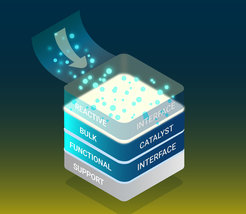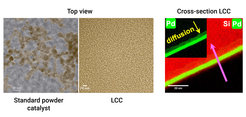Innovative Catalyst Platform Advances Understanding of Working Catalysts
A novel catalyst platform, known as Laterally Condensed Catalysts (LCC), has been developed to enable design and analysis of the functional interface connecting the active mass to its support. This interface not only influences the chemical properties of the reactive interface but also controls its stability and hence the sustainability of the catalytic materials.
Key Features of LCC

Unrestrained combinations in composition between active phase and support enable for example direct energy transfer to the reactive interface in electrocatalysis or electrical heating. The physical synthesis methodology within the FHI-HZB CatLab project, taken from solar cell technology, gives access to precise and homogeneous structures and chemistry. This facilitates the mechanistic understanding of working catalysts and their subsequent optimization through interrogating reactive and functional interfaces by operando spectroscopy. The thin film catalysts studied here were synthesized with the objective of designing the interface structure of performance catalysts and closing the material gap between model and real-world powder catalysts while minimizing the use of noble metals. Its unique flat and densely packed structure (LCC) enables to achieve a homogeneous high density of surface active sites, minimizing the content of material present in the “bulk” or subsurface of the active catalysts with benefical effects on the selelctivity of the catalyzed reaction.
Key Aspects
- Novel Catalyst Platform: The Laterally-Condensed Catalysts (LCC) enable to bridge the gap between complex industrial powder catalysts and single-crystal model catalysts.
- Resource Efficiency: Utilizes a minimal amount of palladium, a noble metal, through a thin-layer design as a landscape of active sites, reducing material costs while maintaining activity.
- Alternative Ethylene Source: Proposes use of waste acetylene from pyrolysis (CO2 mitigation process) instead of steam cracking of fossil fuels, resulting in production of green ethylene.
- Auto-adjustment Capability: Features a unique structure that auto-adjusts, ensuring consistent and reliable performance over time. Specifically, the LCCs allow the dissolution of the optimum amount of C in Pd that is required to favor the semi-hydrogenation reaction route.
Industrial Implications

In the realm of industrial chemistry and keeping in mind the challenging goal of achieving a circular society, converting byproducts into valuable resources is a significant challenge. By addressing safety concerns associated with acetylene and optimizing resource use, this research contributes to safer, more efficient, and environmentally friendly chemical manufacturing. By using renewable source of acetylene from pyrolysis to produce ethylene, the LCC platform aims to increase resource efficiency and support sustainable chemical processes. Although this is fundamental research, it lays the groundwork for future applications that could contribute to greener industrial processes.
Research and Collaboration
This effort is detailed in a study published in Nature Communications, entitled "Rationally Designed Laterally-Condensed-Catalysts Deliver Robust Activity and Selectivity for Ethylene Production in Acetylene Hydrogenation." The study is part of the CatLab Project, a collaboration prominently involving the Fritz Haber Institute of the Max Planck Society (FHI), the Helmholtz-Zentrum Berlin für Materialien und Energie and the Max Planck Institute for Chemical Energy Conversion. The CatLab Project is funded by Federal Ministry of Education and Research (BMBF).
Expert Insights
“I'm excited about the potential of our research to improve catalyst design and deepen our understanding of working catalysts, particularly those that can be employed for the selective ethylene production. Although this is fundamental research, it lays the groundwork for future applications that could contribute to greener industrial processes. Further studies will be necessary to explore these possibilities." said Dr. Katarzyna Skorupska, corresponding author and Group Leader within the Inorganic Chemistry Department at the Fritz Haber Institute.
Prof. Roldan, CatLab principal investigator at the FHI points out the potential of this novel synthesis approach: “Combining the scalable technology of solar cell preparation provided by HZB with the potential of designing the stack of interfaces making a material into a dynamically functioning catalyst brings us a step closer to a de-novo design of catalysts inspired by the advanced operando spectro-microscopy practiced at FHI.”
The editors at Nature Communications have put together an Editors’ Highlights webpage of recent research called “Catalysis” and this paper is featured













